|
| Author |
Message |
bldginsp
Member
|
# Posted: 13 Nov 2014 07:59am - Edited by: bldginsp
Reply
I had a well drilled on my property. Here's some pics of the process used in my particular circumstance.
Hmmm... don't know why they came up rotated... sorry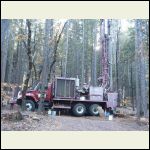
Drill rig
| 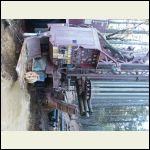
Business end of drill rig
| 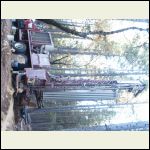
Business end of drill rig 2
| 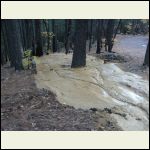
A river of mud
|
|
|
bldginsp
Member
|
# Posted: 13 Nov 2014 08:08am
Reply
The first pic here shows the drilling process. They are sending down a 6" steel casing along with the drill pipe as they drill. Highly compressed air is shot down the drill pipe, and blows the cuttings up through the casing and out the flex hose you see at the top.
The next pic shows the air, cuttings and water being blown out the flex tube.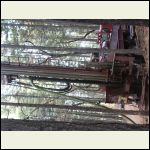
drilling in process
| 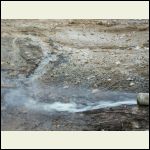
outflow
|  |  |
|
|
bldginsp
Member
|
# Posted: 13 Nov 2014 08:09am - Edited by: bldginsp
Reply
Sorry the pics didn't come out upright. Someone know how to fix this?
So we started drilling last Wednesday and went through 300 feet of clay hitting very little water. There was water in the clay, but it moves very slowly through clay and was producing maybe 1 gpm (gallon per minute).
Then at 300 feet we broke through the clay into a gravel layer that was producing water at about 5gpm. At 320 ft we were boring through old lava flow, which is a porous rock that water will flow through. We bored through that to about 360 feet and it was producing 12 gpm.
So this was decision time- 12 gpm is a decent flow rate and would be enough to pump at a slow rate into a water tank above. But I wanted additional insurance so I said go further.
At 380 feet they were boring through a very hard green rock and the water rate was still about 12 gpm. No improvement. I gave the go ahead to go to 400 ft. At 400 we must have hit a fissure or something because the rate upped to 30 gpm. What a relief!
The water is very clear, sweet tasting with only a little iron, no sand, and will not need filtering like water from a clay layer. That was good luck.
$50 per foot puts the base cost at $20,000, plus cost of a drill bit, gravel and the ground level seal will put the cost of drilling and installing casing at just over $21,000. Then a pump will cost about $700, along with wire cost and installation total about $2000. So total probably a bit over $23k.
You don't know what's down there til you drill, and it's a crap shoot. Sometimes people drill and hit nothing, sometimes they only hit a low flow rate, or dirty water. I consider myself lucky.
|
|
Steve_S
Member
|
# Posted: 13 Nov 2014 08:20am
Reply
Ahhh that's a familiar sight.... Had the well driller on my property for almost 3 weeks... Cable Drilling through very hard granite to 230'.
Got very good fracturing of the rock and great water flow (4.5 gpm) which fills to about 20 feet from the top but ouch on the pocket book. Thank Goodness the casing only had to go 29'... @ $15 a foot that stuff adds a lot to the cost of the well in a hurry.
Here's our guys getting going, slightly different setup. The pics also show where I am putting my current temporary 16x20 cabin and where the Cordwood Cabin will be built in a couple of years.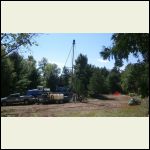
X marks the cabin spot
| 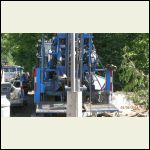
The back of rig
| 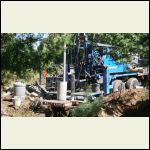
Pounding away "loudly"
|  |
|
|
bldginsp
Member
|
# Posted: 13 Nov 2014 08:46am
Reply
Congratulations on a successful drill, Steve. I guess where you are 4.5gpm is considered good for drilling through granite? I hear water from granite fissures is usually about as good as it gets.
Geology here in Northern California is some of the most complex in the country, according to my driller. Never know what you are going to hit.
Talked to one guy in the coffee shop who said he got to 560 feet and had a flow rate of about 10-15gpm, decided to go further. Hit a green serpentine rock and his flow rate jumped to over 250gpm! The drill rig could not pump any faster.
You never know. As my driller said, "It's just whatever Mother Nature provides".
|
|
Steve_S
Member
|
# Posted: 13 Nov 2014 09:19am
Reply
4.5 gpm for me is good enough... not the best but it is flowing nicely and quite tasty to boot. Costs were $15 a foot for casing, $33 a foot drilling. Add pump, seals, license, certification etc etc etc (lots of those) about 18K all in with taxes. More than I wanted to spend BUT could have been worse no doubt. Being on a hill didn't help but it is what mother nature decided like your driller said.
Fixing Pics, only way I know is to edit them and turn them, then upload. I severely downsized mine as I took the photo's with my camera, not phone and that thing makes 5MB+ pics.
Being in Cali, you got lucky from what I understand as the water table is continually dropping in many Cali areas... Hopefully your not in one of those places, would really suck to have to drill again in a few years... ^%&#(*&^ Droughts !
|
|
toyota_mdt_tech
Member
|
# Posted: 13 Nov 2014 10:31am
Reply
Wow, and I whined about 8K cost on my well, went 178 feet and 15 GPM. I should be thankful I guess.  That was in 2006. Its one of the first things I did after the purchase of the 1st 20 acre lot. That was in 2006. Its one of the first things I did after the purchase of the 1st 20 acre lot.
|
|
Steve_S
Member
|
# Posted: 13 Nov 2014 10:52am
Reply
@Toyota... When we whine or complain about our own situations (which I used to do more often, rarely now) just have to look down the road to see someone having a worse go of it and regain the ever important perspective. Something I learned to accept over the past few decades.
You know something... Just looking at my pics from the drilling start to where I am now on the property and BOY has stuff ever changed in the past couple of months... Those photo's were taken just after the excavation & grading were done and before even the Sea Can arrived on site. Don't notice it so much when working on it daily but looking back on it - sheesh....
|
|
|
bldginsp
Member
|
# Posted: 13 Nov 2014 01:59pm
Reply
On uploading the photos- I did rotate them in my puter before I uploaded them to the site, then they came up on the site the way they were originally taken. So much for windows 8.
Toyota- yes $23k is expensive but in my area there are horror stories. One person had to drill 800 feet, like $40k, another drilled 200 ft and ran out of money so quit, another went 275 ft and got so low a flow she can only pump 1/2 hour. Others have drilled over 500 ft. Such is life.
|
|
Malamute
Member
|
# Posted: 13 Nov 2014 07:34pm - Edited by: Malamute
Reply
Congrats on getting the well in.
15 gpm wasn't enough?
Most pumps we use around here are in the 10 GPM range, any more is more than you can pump out of the well, less works, it just hits the well production rate if you use it enough to run it down that far. It takes running an outside hydrant wide open for 15-20 minutes to use up whats sitting in the casing, then settles into the well production rate of 7 GPM forever.
I think HUD considers 3 GPM to be enough for an average house. I haven't heard of anyone using a cistern tank unless they were in the 1 1/2 GPM range. Mine is 7 GPM and is plenty to water a large area of native grass, running the sprinkler one at a time days at a time. I cant ell the difference in the house if the sprinkler is on or off.
|
|
bldginsp
Member
|
# Posted: 13 Nov 2014 08:54pm
Reply
Malamute- What I've heard is that 10 gpm is what people usually shoot for at a minimum, because in a single family residence that will handle a pressure tank supplying three or four fixtures operating all at once for an extended period of time (watering the grass while taking a shower while running the dishwasher, etc.) And I've heard that 3 gpm is the minimum amount that most banks will accept as being a well that is an asset to the property, and so lendable.
You are right that most people don't use storage tanks, they use pressure tanks to supply the house. This is probably because it's cheaper, easier, and most people don't have enough slope on enough land to develop enough pressure from a storage tank high enough.
Here in California fire country you are required to put in a 2500 gallon storage tank as a fire reserve when you build a residence. So I put one in at the top of my sloping 5 acres. It's about 50 feet vertically above my cabin site, so will produce usable pressure without a pressure tank. If I build a house further up the hill, I'll need a pressure tank with a separate pump to maintain pressure in the house. But for the cabin I'll be fine with gravity feed.
You are right that 12-15 gpm would be plenty. I plan to pump at 5 or 7 gpm anyway. But the reason I went deeper is because I wanted extra insurance against future drought. Supposedly with global warming there will be more and more severe droughts, so I figured while I'm drilling it's the right time to drill a bit further. By shear luck, going another 20 feet gave me 30 gpm, far more than I'll ever need.
Everyone's situation is a bit different, mine's a little unusual I suppose.
|
|
Malamute
Member
|
# Posted: 14 Nov 2014 12:53am - Edited by: Malamute
Reply
Good info.
Yes, it varies quite a bit by region and individual need.
I'm all about tons of water, it would indicate a hedge against lowering water tables. One place I lived produced about 2 1/2-3 gpm I think, but,...it was over 400 ft deep and the static water level was at about 80 or 90 feet, giving quite a nice reservoir to draw on before even getting to the actual well production quantity.
I've heard of some marginal wells in certain areas around here going dry, but they were not very deep or productive to begin with. That drought lasted about 9 years I think. I think the wells that went dry, besides being in a poor well area, were in the under 5 gpm range. Anythings possible though.
I don't have the fire worries, having on site storage is a good idea for a forested area prone to drought and fire.
|
|
bldginsp
Member
|
# Posted: 14 Nov 2014 08:56am
Reply
Before drilling my well, the well driller went on an emergency call to drill for a family in the area whose well had gone dry. They had a shallow well, 90 ft. The driller deepened that to 180 ft. This well was in an agricultural area where there are a lot of farmer's wells. Because of the drought here, the farmers are pulling much more off the aquifers than they used to. The family suspects that the reason they had to pay to deepen their well was because of this.
The ground level in the California Central Valley is dropping because so much water is being pulled for agriculture.
California has a long history of what we call 'water wars' from Owens Valley to dams in the Sierras.
I hope my little well on a remote hillside, far from agriculture or many other wells at all, will be safe. But who knows. There is gold in that mountain, and if they can get the permits to make a mine, they may try. If they do, they'll have to pump the mine, lowering the water table.....
|
|
toyota_mdt_tech
Member
|
# Posted: 14 Nov 2014 10:26am
Reply
Quoting: Steve_S @Toyota... When we whine or complain about our own situations (which I used to do more often, rarely now) just have to look down the road to see someone having a worse go of it and regain the ever important perspective. Something I learned to accept over the past few decades.
I see that now. I consider mine cheap now. A guy 1/4 mile down the road from me had to dig 3 wells before he was successful. The bit got stuck in something and was not able to get it back out, tried again, same deal, but got it back out, then a 3rd time, all over 200 feet each. I know it must of been spendy. But he lives there now and had to have it.
I'm not complaining anymore.  I got a killer deal on my well. I got a killer deal on my well.
|
|
turkeyhunter
Member
|
# Posted: 14 Nov 2014 10:42am
Reply
I paid $695 with pump & tank for my bored well--TOTAL 24 years ago. 30 inch hole~~~ and 60 foot deep and 37 foot of water in it the next morning. Not a bad investment. Pumps still going strong. 24 years ago. 30 inch hole~~~ and 60 foot deep and 37 foot of water in it the next morning. Not a bad investment. Pumps still going strong.
|
|
bldginsp
Member
|
# Posted: 14 Nov 2014 03:21pm
Reply
The water's here, the water's there, but you decided you are going live in one particular place, and get water there and there only, no matter what.
The Indians had it right- they went to the water, rather than expecting it to come to us.
|
|
|

